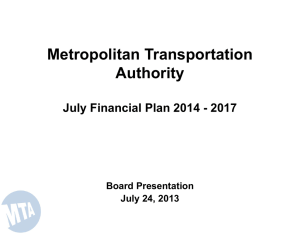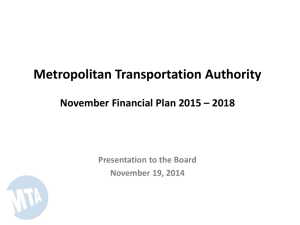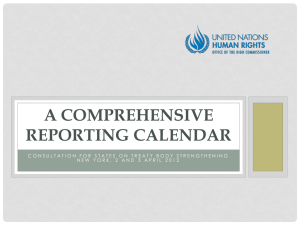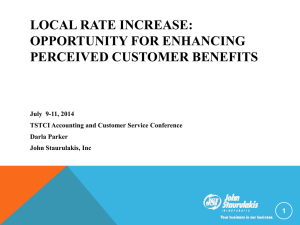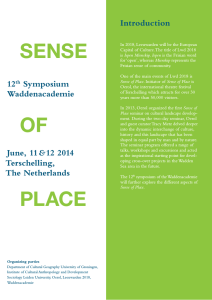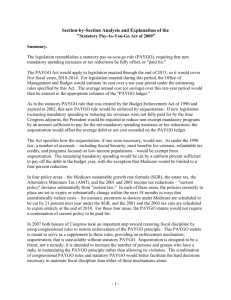Metropolitan Transportation Authority
advertisement
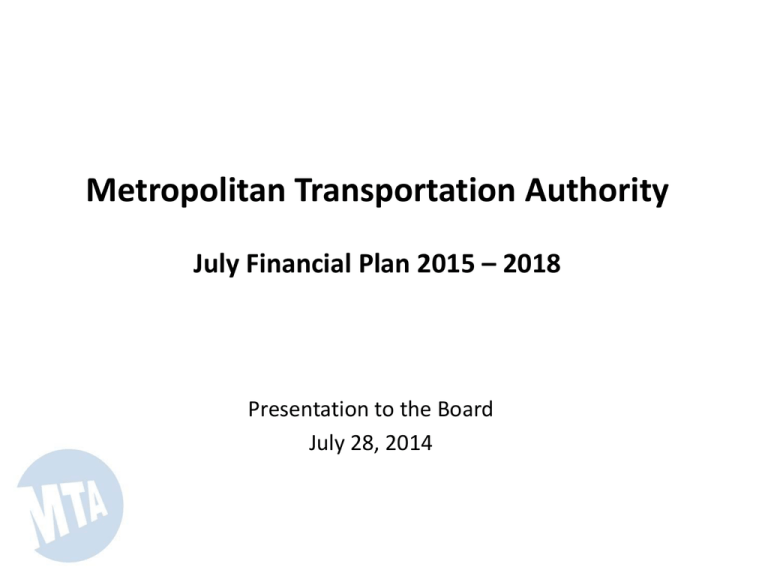
Metropolitan Transportation Authority July Financial Plan 2015 – 2018 Presentation to the Board July 28, 2014 The February Plan projected small cash balances in 2014 to 2016 and a $255 million deficit in 2017 ($ in millions) $100 64 $50 4 9 $0 ($50) ($100) ($150) ($200) Note: Cash balances are carried forward to reduce next year’s deficit ($250) (255) ($300) 2014 2015 2016 2017 1 The February Plan was based on five key, inter-related elements • • • • • Three years of “net zero” labor settlements for all MTA unions Annually recurring cost savings ($1.1 billion in 2014 increasing to $1.5 billion by 2017) Projected fare/toll increases of 4% in 2015 and 2017 No further legislative erosion of PMT revenue $370 million of annual PAYGO capital beginning in 2015 as a “down payment” on the 2015 – 2019 Capital Program As we stated at that time, failure to achieve the first two elements, or any significant decrease in the PMT or any other taxes/subsidies, will require an increase in fares/tolls or a decrease in funds committed to PAYGO capital While we are on track to achieve the annually recurring savings targets, based on recent labor settlements and agreements, 3 “net zero” labor settlements are unachievable 2 What else has changed since the February Plan? • Favorable re-estimates and other changes ― ― ― ― ― ― ― ― ― • Lower health and welfare /OPEB current payment estimates Lower debt service Favorable energy re-estimates in 2015 – 2017 Lower pension re-estimates Higher passenger/toll revenues and other revenue Higher paratransit savings Higher real estate receipts in 2014, nearly offset by lower projections in 2015 – 2017 Delayed impact of East Side Access on operating expenses Reduced 2013 spending that increased carryover balance Unfavorable re-estimates and other changes ― ― ― ― ― Lower PMT receipts Higher overtime re-estimates Higher safety investments Additional operational and maintenance needs Additional service investments and customer enhancements • Re-estimates and other changes are $635 million net favorable through 2017 • However, actual and assumed labor settlements with TWU Local 100 and other unions and potential settlements with CRR unions will increase labor costs by a minimum of $1.28 billion through 2017 • Bottom line is $645 million net unfavorable through 2017 • Reallocation of existing resources is required to offset higher labor costs to avoid raising fares/tolls more than projected and to minimize hit on PAYGO capital 3 Assuming Transit Unions follow the TWU Local 100 pattern and Commuter Unions follow the LIRR Union Coalition pattern, incremental labor costs during the Plan Period increase $478 million in 2014 and an average of $260 million a year ($ in millions) $100 $478 $293 $256 $255 $237 208 207 192 48 48 2016 2017 $0 ($100) ($200) 245 348 45 48 ($300) ($400) 130 ($500) Through 2014 2015 Cost of TWU Pattern for all MTA 2018 Incremental cost of LIRR pattern for CRRs 4 Reallocating resources to fund the higher labor costs avoids the need to raise fares/tolls above current projections, but requires long-term trade-offs ($ in millions) $100 $478 $293 $0 84 ($100) 172 109 ($200) 20 $256 $255 29 21 118 127 29 27 80 80 $237 6 127 24 80 80 ($300) 306 Capital funding capacity is reduced by $1.5 billion ($400) ($500) Through 2014 2015 2016 2017 2018 Favorable Operating Re-estimates OPEB Reserves (2014) and Contributions Supplemental Pension Contribution (offset by loss of ROI Savings) PAYGO contribution 5 Highlights of the July Plan • Funds TWU Local 100 and LIRR Union Coalition pattern settlements from: — — — — • • Favorable re-estimates OPEB reserves and eliminating contributions through 2017 Eliminating supplemental LIRR pension contributions Reducing PAYGO Maintains projected fare/toll revenue increases in 2015 and 2017 of 4% (2% annual increase) Provides PAYGO capital contributions for the 2015 – 2019 Capital Program at a reduced level of approximately $290 million beginning in 2015 ― $2.3 billion of PAYGO over expected eight-year expenditure period, or ― $5.4 billion in funding capacity if PAYGO funds are used for debt service • Invests $363 million in safety improvements over the Plan Period • Invests $125 million in new operational and maintenance needs over the Plan Period • Adds $20 million in additional annual service and service quality investments — In addition to $5 million in annual service guideline adjustments • Continues annually recurring cost savings ($1.3 billion in 2015, increasing to over $1.5 billion in 2017) • Eliminates the projected deficit in year 2017 and reduces the 2018 deficit to $262M 6 Proposed Areas of MTA Safety Investments (not funded from the capital program) MTA will be making safety investments based on: new mandates; recommendations by governmental bodies; compliance with existing laws, policies and procedures; and, new MTA initiatives such as those supporting the “Vision Zero” initiative. Investments will be taking place in the following areas: • Customer/Employee Safety ($40 million per year) - Promote and adhere to a culture of safety with customers and employees via improved work practices and investments in technology and equipment, including the use of audio/visual cameras on commuter rail rolling stock • Track ($17 million per year) - More frequent track inspections and repairs • Signals ($8 million per year) - Upgrades and repairs to signals and signal systems • Training ($6 million per year) - Enhancement of employee training • Positive Train Control ($6 million per year) - Positive Train Control on LIRR and MNR • IT/Communications ($3 million per year) - Enhance safety systems and communications with customers and employees • Right-of-Way ($4 million per year) - More aggressive inspection and maintenance on the right-of-way 7 Highlights of Agency-Proposed 2014 Service and Service Quality Investments • New York City Transit ($13.5 million net annualized) – To improve response times and reduce service delays, permanently establish four Combined Action Teams (CAT) in Manhattan for MOW issues and establish 4-person rapid-response signal teams along the Lexington Avenue corridor; expand J line weekend service; additional bus connections to SI Ferry; additional Bus service to Gateway II Mall; new Select Bus Service (SBS) • Long Island Rail Road ($3.4 million net annualized) – Restore bi-hourly weekend service on the West Hempstead branch; extend hourly weekend service between Babylon and Patchogue to year-round; extend seasonal weekend service to Montauk by ten weeks; restore one weekend round-trip on the Oyster Bay branch; increase capacity on Ronkonkoma, Port Washington, Hempstead, Huntington and Babylon lines; improve signage at Penn Station and outlying stations • Metro-North Railroad ($1.0 million net annualized) - Add a new midday train from Hoboken to Middletown; one year pilot program to reduce daily parking fee from $2.75 to $1.25 f per 16 hours and annual permit from $235 to $20 at all MNR West of Hudson stations • Staten Island Railway ($2.0 million net annualized) - Install arrival clocks at 17 stations; and additional connections with SI Ferry 8 Achieving annually recurring savings targets is key to reducing pressure on future fares/tolls and PAYGO capital ($ in millions) $1,800 $1,600 $1,400 $1,200 $1,000 2014 July Plan 2013 July Plan $800 2012 July Plan 2011 July Plan $600 $400 $200 $0 2010 2011 2012 2013 2014 2015 2016 2017 2018 9 More targeted savings have been identified since the November Plan ($ in millions) $300 $250 66 76 $200 55 53 $150 65 51 $100 49 137 $50 $0 27 46 4 18 26 2014 2015 2016 $1,107 $1,261 $1,435 Implemented Savings Other Identified Savings 114 106 2017 $1,526 2018 $1,521 Unidentified Savings Savings Targets 10 2014 February Plan vs. Proposed July Plan ($ in millions) $200 162 146 $150 $100 113 64 $50 10 4 9 $0 N/A ($50) February Plan Proposed July Plan ($100) ($150) ($200) ($250) Note: Cash balances are carried forward to reduce next year’s deficit (255) ($300) 2014 2015 2016 2017 (262) 2018 11 What is our strategy going forward? • Continue to pursue efficiencies/consolidations to maximize annually recurring cost savings; we must remain focused on existing cost control to avoid “backsliding” • While funding higher labor cost caused us to temporarily divert some of our resources away from our strategy to address long-term costs and liabilities, we remain committed to this objective – Although the July Plan suspends OPEB contributions through 2017, contributions are resumed in 2018, albeit at a much lower level – Should finances improve, we intend to increase funding to the extent practicable • Use non-recurring revenues, favorable budget variances and unused general reserve funds to reduce long-term unfunded liabilities—OPEBs, LIRR Additional Pension Plan or as PAYGO – Simply put, this strategy converts favorable “one- shots” into recurring savings • Reinvest debt service savings in PAYGO capital 12
